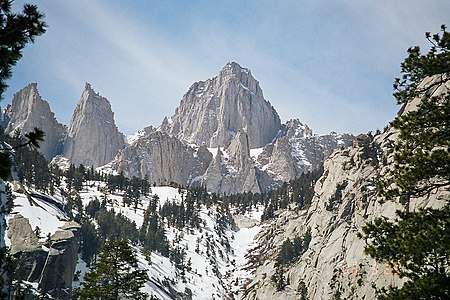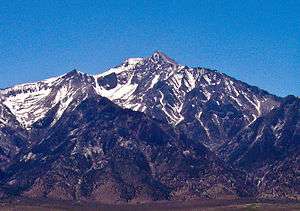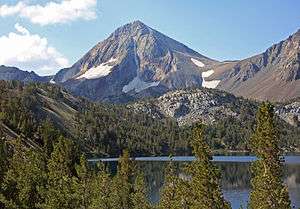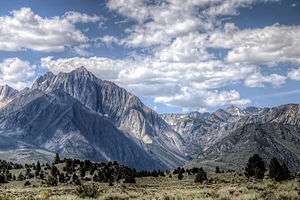Sierra Peaks Section
The Sierra Peaks Section (SPS) is a mountaineering society within the Angeles Chapter of the Sierra Club that serves to provide mountaineering activities for Sierra Club members in the Sierra Nevada, and to honor mountaineers who have summited Sierra Nevada peaks.
History
The Sierra Peaks Section was established in 1955. The Section maintains historic summit registers at Bancroft Library on the University of California, Berkeley campus.[1]
Membership
To become a member of the SPS, one must be a Sierra Club member and have climbed at least six peaks on the SPS List; it is not necessary that the peaks be Emblem peaks. For verification purposes, two of those ascents must be done on an official SPS trip.[2]
Especially accomplished members are award with emblems, with the following grades (from highest to lowest):[3]
- Third List Completion
- Second List Completion
- First List Completion
- Master Emblem
- Senior Emblem
- Emblem
Upon receiving one of the normal emblems, members may be recognized with one of the following additional emblems, which are not ranked:
- Geographic Emblem
- Explorer Emblem
SPS List
To the general public, they are most known for their peak bagging list, created in 1955, a product of the Sierra Club's long legacy of promoting climbing in the Sierra Nevada.[4] Completing the list is highly prestigious in American mountaineering circles, and climbers who complete the list are often cited as having done so (e.g. by the American Alpine Club).[5]
The list is divided into three levels of importance. The Emblem peaks are considered the most iconic peaks of the Sierra Nevada, and to summit all of them is the goal of many peak baggers and alpinists. Mountaineers peaks are less notable peaks known for presenting mountaineering challenges; they do not have the prestige that Emblem peaks have attached to them, but ascending them is necessary to gain higher levels of recognition for Section members. Finally, there are the numerous general peaks of lesser note.[6]
Some peaks require substantial rock climbing experience (e.g. North Palisade and Mount Clarence King), and in some cases snow travel skills. Most peaks may require few technical skills, although the commonly cited difficulty ratings of peak climbs in the Sierra Nevada are considered to be understated, or “sandbagged”. [7][8] The majority of peaks are very remote and require substantial cross-country travel.
The list is an example of a subjective "decision by committee" list with the peaks on the list being determined by the Sierra Club. Peaks are occasionally added or removed from the list due to a variety of factors, such as accessibility, notability, and interest.[9] The list is followed by thousands of hikers and climbers and has been noted in numerous books and guides on the Sierra Nevada.
There are 15 Emblem peaks, 35 Mountaineers peaks, and 197 general peaks, for a total of 247 peaks.[10] The number of peaks is traditionally set at 248, the original number of peaks listed in 1955; however the number changes at times due to issues such as legal access or higher interest in one peak over another.
The elevations listed below are those officially described on the list (based on USGS topographic map contours), and may not be the actual elevations of those peaks, although they are usually accurate to within 50 feet.
Emblem Peaks


| Peak[6] | Elevation |
|---|---|
| Olancha Peak | 12,123 feet (3,695 m) |
| Mount Whitney | 14,491 feet (4,417 m) |
| Mount Williamson | 14,370 feet (4,380 m) |
| Mount Kaweah | 13,802 feet (4,207 m) |
| Mount Brewer | 13,570 feet (4,140 m) |
| Mount Clarence King | 12,907 feet (3,934 m) |
| Split Mountain | 14,042 feet (4,280 m) |
| Mount Goddard | 13,568 feet (4,136 m) |
| North Palisade | 14,242 feet (4,341 m) |
| Mount Darwin | 13,831 feet (4,216 m) |
| Mount Humphreys | 13,986 feet (4,263 m) |
| Mount Abbot | 13,704 feet (4,177 m) |
| Mount Ritter | 13,143 feet (4,006 m) |
| Mount Lyell | 13,114 feet (3,997 m) |
| Matterhorn Peak | 12,279 feet (3,743 m) |
Mountaineers Peaks


| Peak[6] | Elevation |
|---|---|
| Mount LeConte | 13,930 feet (4,250 m) |
| Mount McAdie | 13,799 feet (4,206 m) |
| Mount Russell | 14,088 feet (4,294 m) |
| Black Kaweah | 13,720 feet (4,180 m) |
| Triple Divide Peak | 12,634 feet (3,851 m) |
| Milestone Mountain | 13,638 feet (4,157 m) |
| Table Mountain | 13,632 feet (4,155 m) |
| Thunder Mountain | 13,517 feet (4,120 m) |
| Mount Ericsson | 13,583 feet (4,140 m) |
| Deerhorn Mountain | 13,281 feet (4,048 m) |
| East Vidette | 12,356 feet (3,766 m) |
| Junction Peak | 13,845 feet (4,220 m) |
| University Peak | 13,589 feet (4,142 m) |
| Mount Gardiner | 12,907 feet (3,934 m) |
| Arrow Peak | 12,959 feet (3,950 m) |
| Mount Ruskin | 12,920 feet (3,940 m) |
| Tehipite Dome | 7,708 feet (2,349 m) |
| Middle Palisade | 14,012 feet (4,271 m) |
| Norman Clyde Peak | 13,855 feet (4,223 m) |
| Devil’s Crag #1 | 12,400 feet (3,800 m) |
| Mount McDuffie | 13,282 feet (4,048 m) |
| Mount Sill | 14,153 feet (4,314 m) |
| Thunderbolt Peak | 14,003 feet (4,268 m) |
| The Hermit | 12,328 feet (3,758 m) |
| Seven Gables | 13,080 feet (3,990 m) |
| Bear Creek Spire | 13,720 feet (4,180 m) |
| Red Slate Mountain | 13,123 feet (4,000 m) |
| Mount Morrison | 12,277 feet (3,742 m) |
| Clyde Minaret | 12,264 feet (3,738 m) |
| Mount Clark | 11,522 feet (3,512 m) |
| Mount Starr King | 9,092 feet (2,771 m) |
| Cathedral Peak | 10,911 feet (3,326 m) |
| Whorl Mountain | 12,033 feet (3,668 m) |
| Tower Peak | 11,755 feet (3,583 m) |
Full list
Area 1: Southern Sierra
- Pilot Knob (suspended)
- Owens Peak
- Spanish Needle
- Lamont Peak
- Sawtooth Peak
- Rockhouse Peak
- Taylor Dome
- Sirretta Peak
- Crag Peak
- Smith Mountain
Area 2: Mineral King and Kern River
- Kern Peak
- Angora Mountain
- Coyote Peaks
- North Maggie Mountain
- Moses Mountain
- Homers Nose
- Vandever Mountain
- Florence Peak
- Sawtooth Peak
- Needham Mountain
Area 3: Olancha to Langley and west
- Olancha Peak
- Cartago Peak
- Muah Mountain
- Cirque Peak
- Mount Langley
- Mount Guyot
- Joe Devel Peak
- Mount Pickering
- Mount Chamberlin
- Mount Newcomb
- Mount Hitchcock
Area 4: Corcoran to Whitney
- Mount Corcoran
- Mount LeConte
- Mount Mallory
- Mount Irvine
- Mount McAdie
- Mount Muir
- Mount Whitney
- Thor Peak
- Lone Pine Peak
Area 5: Whitney to Williamson
- Mount Young
- Mount Hale
- Mount Russell
- Mount Carillon
- Tunnabora Peak
- Mount Barnard
- Trojan Peak
- Mount Tyndall
- Mount Williamson
Area 6: Kaweahs and west
- Alta Peak
- Mount Silliman
- Mount Eisen
- Lippincott Mountain
- Eagle Scout Peak
- Mount Stewart
- Lion Rock
- Mount Kaweah
- Red Kaweah
- Black Kaweah
- Picket Guard Peak
- Kern Point
Area 7: Great Western Divide
- Triple Divide Peak
- Glacier Ridge
- Whaleback
- Milestone Mountain
- Midway Mountain
- Table Mountain
- Thunder Mountain
- South Guard
- Mount Brewer
- North Guard
Area 8: Kings–Kern divide
- Mount Jordan
- Mount Genevra
- Mount Ericsson
- Mount Stanford
- Deerhorn Mountain
- East Vidette
- West Vidette
- Junction Peak
- Mount Keith
- Mount Bradley
- Center Peak
- Caltech Peak
Area 9: Kearsarge Pass vicinity
- University Peak
- Independence Peak
- Kearsarge Peak
- Mount Gould
- Mount Rixford
- Mount Bago
- Mount Gardiner
- Mount Cotter
- Mount Clarence King
- Dragon Peak
- Black Mountain
- Diamond Peak
Area 10: Baxter Pass to Taboose Pass
- Mount Baxter
- Colosseum Mountain
- Mount Perkins
- Mount Wynne
- Mount Pinchot
- Pyramid Peak
- Arrow Peak
- Striped Mountain
- Goodale Mountain
- Cardinal Mountain
Area 11: Western mid-Sierra
- Mount Ruskin
- Marion Peak
- State Peak
- Goat Mountain
- Kennedy Mountain
- Mount Harrington
- Tehipite Dome
- Spanish Mountain
- Three Sisters
Area 12: South Palisades
- Split Mountain
- Mount Tinemaha
- Mount Prater
- Mount Bolton Brown
- Birch Mountain
- The Thumb
- Disappointment Peak
- Middle Palisade
- Norman Clyde Peak
- Palisade Crest
Area 13: Mt. Goddard vicinity
- Observation Peak
- Giraud Peak
- Devil's Crag #1
- Wheel Mountain
- Mount McDuffie
- Black Giant
- Charybdis
- Scylla
- Mount Goddard
- Mount Reinstein
- Finger Peak
- Tunemah Peak
Area 14: North Palisades
- Temple Crag
- Mount Gayley
- Mount Sill
- North Palisade
- Thunderbolt Peak
- Mount Winchell
- Mount Agassiz
- Mount Goode
- Cloudripper
- Mount Johnson
- Mount Gilbert
Area 15: Evolution area
- Mount Thompson
- Point Powell
- Mount Wallace
- Mount Haeckel
- Mount Fiske
- Mount Huxley
- Mount Darwin
- Mount Mendel
- Mount Lamarck
- The Hermit
- Mount McGee
- Emerald Peak
- Mount Henry
Area 16: Humphreys Basin and west
- Mount Goethe
- Mount Emerson
- Mount Humphreys
- Basin Mountain
- Four Gables
- Mount Tom
- Pilot Knob
- Gemini
- Seven Gables
- Mount Senger
- Mount Hooper
Area 17: Bear Creek Spire area
- Merriam Peak
- Royce Peak
- Mount Julius Caesar
- Mount Hilgard
- Recess Peak
- Mount Gabb
- Bear Creek Spire
- Mount Dade
- Mount Abbot
- Mount Mills
- Mount Morgan
Area 18: Mono Creek to Mammoth
- Silver Peak
- Mount Izaak Walton
- Red and White Mountain
- Red Slate Mountain
- Mount Stanford
- Mount Morgan
- Mount Baldwin
- Mount Morrison
- Bloody Mountain
Area 19: Ritter Range and vicinity
- Iron Mountain
- Clyde Minaret
- Mount Ritter
- Banner Peak
- Mount Davis
- Rodgers Peak
- Electra Peak
- Foerster Peak
- San Joaquin Mountain
Area 20: Clark Range and vicinity
- Merced Peak
- Red Peak
- Gray Peak
- Mount Clark
- Mount Starr King
- Half Dome
- Clouds Rest
Area 21: Mt. Lyell and north
Area 22: Tioga Pass to Bond Pass
- Mount Warren
- Mount Conness
- North Peak
- Excelsior Mountain
- Dunderberg Peak
- Virginia Peak
- Twin Peaks
- Whorl Mountain
- Matterhorn Peak
- Pettit Peak
- Volunteer Peak
- Piute Mountain
- Tower Peak
Area 23: Bond Pass to Lake Tahoe
- Black Hawk Mountain
- Leavitt Peak
- Stanislaus Peak
- Disaster Peak
- Highland Peak
- Mokelumne Peak
- Round Top
- Freel Peak
- Pyramid Peak
- Dicks Peak
- Mount Tallac
Area 24: Northern Sierra
- Granite Chief
- Tinker Knob
- Castle Peak
- Mount Rose
- Mount Lola
- English Mountain
- Sierra Buttes
- Mount Elwell
- Adams Peak
References
- "Sierra Peaks Section Brief History".
- "Sierra Peaks Section Membership Page".
- "Sierra Peaks Section Emblem Introduction Page".
- Andy Selters. Images of America: Inyo National Forest. p. 83
- 1997 American Alpine Journal. p. 394.
- SPS List, 20th edition
- Drummond, Lizz (2013-09-03). "Numbers Game: Classic Sandbags at 4 Historic Crags". Climbing Magazine. Retrieved 2020-07-18.
- https://adventuresportsjournal.com/ten-favorite-high-sierra-climbs/
- Helman, Adam. The Finest Peaks - Prominence and Other Mountain Measures.
- "Sierra Peaks Section". SummitPost.org.
Bibliography
- Secor, R. J. (2009). The High Sierra : peaks, passes, trail. Seattle, WA: Mountaineers Books. ISBN 978-0-89886-971-2.